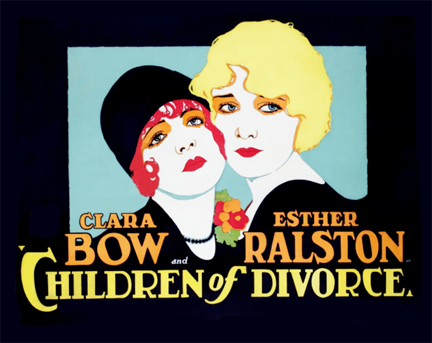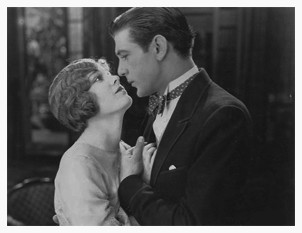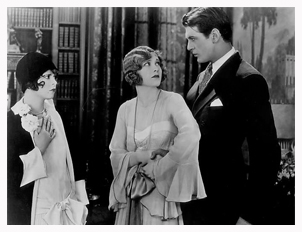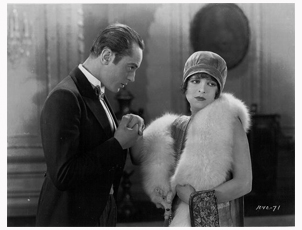

Release date: April 25, 1927
Produced by Famous Players-Lasky Corporation
71 minutes
Directed by Frank Lloyd
Cast: Clara Bow (Kitty Flanders), Esther Ralston (Jean Waddington), Gary Cooper (Ted Larrabee), Einar Hanson (Prince Vico de Saxe), Norman Trevor (Duc de Goncourt), Hedda Hopper (Katherine Flanders), Edward Martindel (Thomas Larrabee), Joyce Coad (Little Kitty), Yvonne Pelletier (Little Jean), Don Marion (Little Ted)
Without a doubt, "Children of Divorce" is a heavy drama, and without the presence of three top-notch stars, would likely be overlooked as just another melodrama. However, the stars are the main attraction of this feature, and due to their presence, the film is taken to a higher level.
It begins with a boarding school outside of Paris renowned
for taking in children of divorced parents who want to be free
of their parental responsibilities until they come to take their
 children on a "vacation"
each summer. The film emphasizes the lack of love these children
feel, and it seems the girls, at least, are raised to seek out
wealthy husbands if wealth does not already exist.
children on a "vacation"
each summer. The film emphasizes the lack of love these children
feel, and it seems the girls, at least, are raised to seek out
wealthy husbands if wealth does not already exist.
Kitty arrives at the school as a young girl and is immediately befriended by the older Jean. The friendship deepens between the two girls with the elder Jean taking on the role of comforter and protector of the younger Kitty. Before the story leaves their school days, we also see their first meeting with Ted ( who does NOT) attend the school and ends with Jean and Ted vowing to marry one another one day. Some later scenes with the two girls as adults reflect back in an almost identical fashion to moments together as children in the school - a most dramatic and effective use of flashbacks by director Frank Lloyd.
Years later we see Ted and Kitty in high society, neither
married yet. Kitty and her mother are not wealthy while Ted and
his father are very wealthy. Of course, both parents are still
divorced - the theme that is carried throughout the story.
Jean, who is very wealthy, returns after several years of traveling,
and the trio are reunited. Of course, Jean and Ted reignite their
romance, but she rebuffs his marriage proposal because he has
set aside his dream of building bridges for an irresponsible lifestyle
of wealthy leisure. Their marriage can only be when he has proven
himself a responsible, working man. Kitty, on the other hand,
is in love with Prince Vico, but she refuses to marry him because
her mother has "drilled" into her the need to marry
wealth - which the Prince's father has also instructed him to
do.
The story is very entertaining to this point but turns very soap opera-ish for its second half. For his love of Jean, Ted gets serious about life and uses his engineering degree to join a company that builds bridges. However, Kitty and her friends arrive at his office ready to party and convince him to indulge in one last night of revelry. Unfortunately he wakes up the next morning married to Kitty and with no memory of the previous night's events. As he is agonizing over his situation, a note arrives from Jean apologizing for putting him off and offering to marry him any time he wishes - only adding to the tragedy of his predicament.
These seemingly insurmountable situations do make for a good story that grab our interest, however the best stories resolve these dilemmas with an ingenious plot twist, something that we, as viewers, don't typically figure out ahead of time and find as a pleasant surprise. Unfortunately, that is not the case here. For a writer, a death is always a less creative way to get out of a corner in which you have written your characters.
The New York Times called the story "unconvincing."
(1) Variety said, "It's a society drama of the type
of which the American picture patron has had more than a smattering."
(2) So, for 1927 audiences, there was nothing spectacular here
by way of a story line, but it does have its moments - as The
New York Times reviewer noted, ". . . This film succeeds
in holding the  attention
thanks to the excellent lighting effects and to the presence of
Esther Ralston and Clara Bow." (3)
attention
thanks to the excellent lighting effects and to the presence of
Esther Ralston and Clara Bow." (3)
The early scenes with the girls in boarding school are charming and enjoyable. Kitty, smaller than most of the other children, seems to be rebuffed by them all until Jean, taller by a few inches, comes along, and the two walk away with their arms around each other's waist. One scene shows the young Kitty coming to Jean's bed exclaiming that she is afraid. In bed, wrapped in Jean's arms, she goes to sleep peacefully. Summer comes, and both girls are awaiting their parents to come and take them away. While all of the other children are claimed by their parents, Kitty and Jean stand all alone and sad. This scene is lifted from the sad to happy when it ends with their meeting Ted.
In spite of their closeness as children, the two have grown to be two totally different personalities - Kitty the vivacious, love of life, party girl (obviously a role made to order for Clara Bow) - Jean the reserved, dignified and sweet ever proper lady. This disparity is the basis for our conflict in the story. Kitty determined to marry for money takes advantage of a drunken evening with Ted and marries him.
Considering the friendship of the two girls, this is somewhat puzzling, but Kitty justifies her action by reminding Jean, "You had your chance! I warned you I'd marry him if you didn't!" Jean, on the other hand, being the ever faithful friend, convinces Ted he should see the marriage through, and leaves to travel the world.
Vintage reviews were in agreement that the story lacked strength, but they were equally in agreement that the strongest aspect of the film was the presence of Clara Bow and Esther Ralston. Keeping in mind that both ladies were major stars and Gary Cooper was a minor, up-and-coming star, it's easy to understand why reviews didn't give Cooper as much credit as the two headliners. But for us today, we welcome Gary Cooper's presence in a film, and he gives a good, albeit not outstanding, performance that reminds one of Douglas Fairbanks, Jr., in "A Woman of Affairs" (1928). One review says "(he) gives an interesting account of (himself). (4) Another said, ". . . (he) does well enough as the hero," (5) and yet another said, "Gary Cooper will likely find himself more at home in westerns." (6)
Regarding the ladies, Variety said, "Esther Ralston rings true on her 'class' impersonation, and there is no doubt that both starred girls take the picture away from the men." (7) The New York Times reviewer said, "Miss Ralston does very well as the beautiful Jean. Miss Bow is pretty and active as Kitty." (8)
The divorce theme certainly figures prominently in the dialogue
but doesn't really control the story line. Jean does tell Ted
they should be very sure before they marry so their children  won't be children of divorce as
they are. In another instance when Jean learns of Ted and Kitty's
sudden marriage, Kitty tells Jean "All your life you've preached
against divorce! It's different now, isn't it -- when you want
another woman's man?" If anything, the story may be a lesson
in marrying for love instead of position or money since the latter
is more likely to lead to unhappiness and divorce.
won't be children of divorce as
they are. In another instance when Jean learns of Ted and Kitty's
sudden marriage, Kitty tells Jean "All your life you've preached
against divorce! It's different now, isn't it -- when you want
another woman's man?" If anything, the story may be a lesson
in marrying for love instead of position or money since the latter
is more likely to lead to unhappiness and divorce.
As noted, the stars are the attraction of this film, and certainly, as The New York Times noted, it does "succeed in holding the attention." Its weakest point is probably the ending, but the rest of the film will entertain sufficiently. And although vintage reviews didn't fawn over the acting, the performances by the three principals are worthy of praise. Being a major Paramount production, coupled with elegant, high society settings, the film is very visually appealing. Ralston's beautiful, sleek gowns are reason alone to see the film.
No, "Children of Divorce" may not be one of the ten best films of the silent era, but silent films fans should not cease in their praise of Flicker Alley in bringing this film to high quality Blu-Ray with a typically fabulous score by the Mont Alto Motion Picture Orchestra. Picture quality is excellent with only a few minor moments of decomposition. And with a cast of stars of this magnitude, who could resist owning a copy?
1. "Children of Divorce" review. The New York
Times. April 26, 1927.
2. "Children of Divorce" review. Variety. April 20,
1927.
3. The New York Times.
4. Ibid.
5. "Children of Divorce" review. Harrison's Reports.
May 14, 1927.
6. Variety.
7. Ibid.
8. The New York Times.
Copyright 2017 by Tim Lussier. All rights reserved